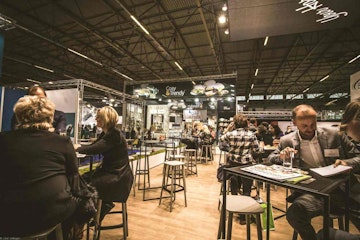Trade shows usually involve a huge amount of planning for exhibitors, but it is the individual details that can truly make them memorable. If you personalise the visitor experience, you can make your presence at a trade show resonate powerfully with the people who come to your stand.
At a trade show, footfall is important – in a recent study 83% of exhibitors chose meeting potential customers as one of the main advantages of trade shows - but it is not just about the numbers. Experiential marketing must be at the heart of how it works, and this is all about engagement.
Similarly to how successful public speakers make each individual member of the audience feel like they are being addressed personally, successful trade show exhibitors will create a unique experience for visitors to their stand.
Source: Display Wizard Trade Show Survey 2017

What is Experiential Marketing?
Experiential marketing is a strategy where you create experiences that directly engage with your target audience, encouraging their participation with your brand.
They become part of the evolution of your brand.
In terms of the trade show, it means that they cannot simply be spectators, if you want to successfully market to them and, ultimately, turn them into prospects.
You must engage with them.

Why Engagement Matters
The more engaging the experience, the more likely it is that you will be able to successfully follow-up with a prospect. 65% of trade show attendees said events help them give a greater understanding of a product or service, showing that – when done correctly – trade shows can be more engaging than online, TV or printed advertising.
A trade show may be as vast as visiting a giant supermarket, but the individual experience should be much closer to that of visiting a small, corner shop. It has to be personal.
Visitors want to feel welcome, and to feel that someone wants to engage with them.
This is a two-way process. Visitors are not simply passive receptors of messages, waiting to be sold to. They are an essential part of the dynamic of a successful trade show whose feedback could help shape your business practice in the future.
All Interaction Counts
The visitor experience at a trade show includes all forms of interaction. This means that if you are present on your stand, you are contributing to that experience whether you have planned it or not.
However, if you occupy a stand and look disinterested, unapproachable or simply spend the time glued to your laptop, then this sends out a signal to visitors. If you appear unfriendly, you will push visitors away.
It’s not just new prospects you want to engage with at a trade show: 44% of exhibitors believe that meeting existing customers is one of the main advantages of exhibiting, showing how trade shows can help develop more personal business-client relationships.
Focus on Experience Not Selling
Obviously the reason for exhibiting at a trade show to attract interest and to drum up potential business, but do not make selling the focus of your activity.
Remember: people do not like being sold to, unless they are ready. As any good sales person knows, experiential marketing is very much about making visitors comfortable and engaging with them to generate interest.
Resist making the hard sell your ultimate goal, but instead focus on the process of engagement and how to maximise this.
The selling comes much later, once you start following up your leads.
Personalise Your Trade Show at Every Stage
Your presence at a trade show should be highly personal every step of the way.
At every stage, consider how appropriate the message is for its intended audience, and how it will work to attract and engage them.
For this, you need to get the fundamentals right:
1. Before the Show
Understand things from your visitors’ viewpoint. What are their pain points that your product or service is addressing?
How can you help them get what they want or need?
Think about the benefits of the product or service you are representing and the kinds of questions visitors might have.
This information should help you put together the messages and promotional material for your stand, and set the tone for the experience and how you will engage with your audience.
See our guide on How to Design the Perfect Display Stand for more ideas on creating a stand design that attracts attention.
Top Tip: Don't put too much information on your display stand - a few key selling points will suffice - the average visitor will spend less than 5 seconds making a first impression so don't overload your design with too much info!
2. Greetings and Questions
Work hard at being personable and engaging on a one-to-one level. Visitors can too easily simply drift past if you fail to engage with them on a personal level.
How you greet visitors to your stand sets the tone for this. You don’t want to rehearse greetings and questions to the extent that you sound unspontaneous and insincere, but you do want to get the first interaction right.
Your body language is key to making a positive first impression: make eye contact and ask the visitor a question or just say a friendly ‘Hello’ to get the ball-rolling.
When they have stopped to engage with you, give them space to ask any questions they have for you first, before qualifying them to find out more about their background.
These questions should be all about what they are looking for. Resist launching into talking about your product or service straight away. Let them know they are the focus of attention here.
3. What's on your Stand?
Even the driest of businesses can use promotional material to liven up an exhibition stand. Try to be inventive or even quirky.
Consider using unique competitions where the passer-by has to interact with your brand or even using innovative experiences such as through using AR or VR – a highly personal means of getting the visitor to engage with your brand.
The design aspect of your stand can be crucial in attracting visitors to it. Treat it like your shop window display.
Similarly, consider what promotional giveaways you can provide. The more tailored these are to your target demographic at the show, the better.
The important thing is to look like you’re really taking into account how your visitors will interact with your exhibition stand.
4. The Follow-Up
Following up your trade show leads is critical and without it your experience marketing efforts will be largely wasted.
If you engage effectively with visitors to your stand and take their details, you must follow-up on this information.
Also, vitally, you must consider the whole tone of this approach. There’s no point in personalising the visitor experience only to follow it up with a pushy or inappropriate sales call.
For new leads at the show, make detailed notes about the person and their requirements so you can follow-up with specific solutions to their needs. This will impress the prospect and make them far more likely to become a customer in the long term.
Summary
Trade shows have the potential to be a hugely effective form of marketing, but only if you take the time to personalise the visitor experience.
Trade shows allow you not only the potential to meet new prospects but also the individual connections you can make, which could be more long-lasting if they start on a personal note.
You can only do this by focusing on your audience as individuals.
All business is competitive, and this really comes home in the atmosphere of a trade show. You are surrounded by competitors on other stands, all looking to gain the attention of the audience you all share.
Therefore, how you engage personally with visitors and how you attract them to your stand, are all crucial in differentiating your brand and creating a memorable impression.








